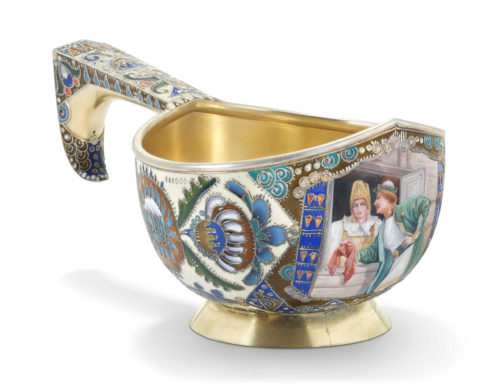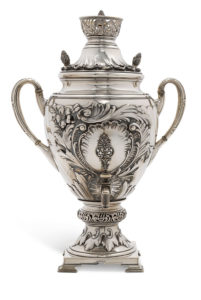Sotheby’s Russian sale in June did pretty well, as we reported earlier. Christie’s 305-lot on-line auction didn’t get going till July 1 (running through July 21) and is of vastly inferior quality. It’s also impossible to navigate: the auction is broken up into over 30 mini-sections with everything scattered all over the place – an asinine idea. A batch of enamels here… three or four pictures up next… then half-a-dozen pieces of Fabergé…. Just looking at this crazy auction on your computer will make your head spin.
FABERGÉ
The sale’s three-dozen lots of Fabergé are bits and bobs of little interest. Lot 31 is a translucent yellow photo-frame by Perchin (c.1890) that I once owned, till my ex absconded with it, shame it is a bit scratched up, (est. £18-22,000). All the mundane, entry-level Fabergé is epitomized by a primitive, common, nothing-to-it, round white desk clock by Wigström (Lot 34) whose £50-70,000 estimate is way over the top. The chances of it making £50,000 are nil.
ENAMELS
Over fifty lots of enamel are strewn around the sale – most of it stuff from dealers, and we’ve seen it so often that when I look at it I want to cry. To call it ‘antique’ defies the Trade Descriptions Act. It’s utilitarian, mass-produced, commercial merchandise that only seems fairly rare because, in Bolshevik times, a lot of it was melted down for the silver content.
Just a couple of items have an ounce of value and appeal to collectors: a Rückert kovsh with an en plein miniature depicting a couple in traditional Russian costume (Lot 216, £30-50,000) and an interesting, unusual silver/enamel photograph frame by Sazikov shaped like a horse’s yoke (Lot 83, est. £12-18,000). I had a similar piece by Sazikov years ago.

A cloisonné and en plein enamel silver-gilt kovsh

A large champlevé and en plein enamel parcel-gilt silver photograph frame shaped as a horse yoke
SILVER
The sale harbours a biblical 30 lots of silver, some of them treacherously containing batches of non-matching items from differing periods. Lot 284 is a group of trompe-l’œil table articles by various makers, casually dated ‘19th/early 20th century’ (est. £4,000-6,000). Lot 287 involves half-a-dozen parcel-gilt charkas, labelled ‘various makers, 18th/19th century (est. £2,000-3,000) – who the hell needs these little bits of useless silver? Maybe scrap dealers, not collectors. Lot 275, with its ‘table articles’ in Tula steel (c.1800), is just a bunch of junk (est. £4,000-6,000).
If I had to pick out one decent-looking piece, it would be a parcel-gilt silver samovar made by Kurlyukov in Moscow around 1890 (Lot 280, est. £15-25,000). The item with the highest estimate, though, is a silver tankard from 1747 with the mark of Boris Gavrilov (Lot 263, est. £20,000-30,000) – another B.I. candidate.

A parcel-gilt silver samovar
PORCELAIN
There are a couple of Imperial Porcelain military plates of wonderful quality (Lots 257/8, est. £20-30,000 apiece) – one with a trumpeter from a Cossack Regiment (1832), the other a soldier from the Hussars (1841). These plates are highly collectable, but we see them in every sale – God knows how many were produced.
The overall standard of the 30 or so pieces of Tsarist-era porcelain is weak. Lot 146, an early 19th century Gardner Peasant Woman figurine, is what I’d call mass-produced junk (est. £2,000-3,000).
There are fifteen pieces of Soviet porcelain, starting with a kitschy, flower-patterned Sovnarkom propaganda plate from 1921 (Lot 1, est. £20-300,00). Anything Soviet is repugnant to me, especially art glorifying Soviet symbols, slogans or portraits of monsters like Lenin and a plethora of other murderers of Russians. In some weird way we have to be grateful to them for their destruction of Russian art, thereby making it so rare and desirable. Just imagine how much Fabergé, enamels and silver would be on the market today had it not been for assiduous efforts by Bolsheviks to destroy the Old World in the hope of building a new one. Destroy and pilfer they did alright – shame their New World didn’t work out.

A soviet propaganda porcelain inkstand
I don’t understand people who collect stuff that glorifies the Soviet Union – a country that doesn’t exist any more. The minute Lenin came to power he outlawed all imperial symbols, yet Russia has yet to cleanse itself by destroying all this Soviet rubbish. The Nazis loved porcelain, too – the Teutonic ideal of a pure white substance made from German earth. Allach Porcelain was made on Himmler’s orders by slave labour from Dachau concentration camp. The factory was shut down in 1945 and most Allach porcelain was destroyed, though you can find some on a couple of niche German auction websites. The big firms won’t go near it. You don’t see anything like the same amount of Nazi memorabilia on the market as Soviet stuff. The swastika is pretty much outlawed, and rightly so, yet the hammer and sickle – in whose name untold millions were sent to their graves – is like a badge of honour, available everywhere.

A soviet porcelain plate
OTHER ITEMS
Only two of the sale’s sixty Pictures are expected to clear a modest £200,000: an ultra-typical Arkhipov Peasant Girl (Lot 39) and a rather more striking Vera Rokhlin View of Tbilisi (Lot 55). The sale’s dozen or so Icons are as boring as they come, with the single exception of an early 20th century silver-gilt/enamel Kazan Mother of God with seed-pearls (Lot 173, est. £15-25,000) – but even that is hardly a rarity.
Pick of the half-dozen Bronzes is a seated figure of Peter the Great by Alexander Opekushin, 2ft high and cast by Sokolov around 1872 (Lot 190, est. £24-30,000). Peter is shown with his left arm resting on a cane and a scroll at his feet inscribed (in Cyrillic) St Petersburg will be founded here. I don’t remember ever seeing this model, so it’s gotta be rare!
There are also some lesser Military Orders and some Weapons – which I admit I know little about – plus some trinkets and low-grade jewellery. The sale ends with 13 lots of what you might generously term ‘Documentation.’ Take Lot 296, catalogued as ‘a large collection of large and small photographs.’ In other words, a bunch of shit. Good luck getting to the £2,000-3,000 estimate!
*
Why have Christie’s put together a sale like this? It’s the first time in years that I will not bother to view a sale in advance – because there’s nothing there to see. The sale is pathetic, laughable, Christie’s worst ever. It’s a sale of bric-à-brac, not antiques… e-Bay material. I predict that results will be absolutely miserly. A sale like this impugns the reputation of the Russian art market and makes it look moribund. And that is not the case! The market is still going strong – as Sotheby’s sale showed. Clients are ready and willing to spend serious money on good stuff, even on-line.









